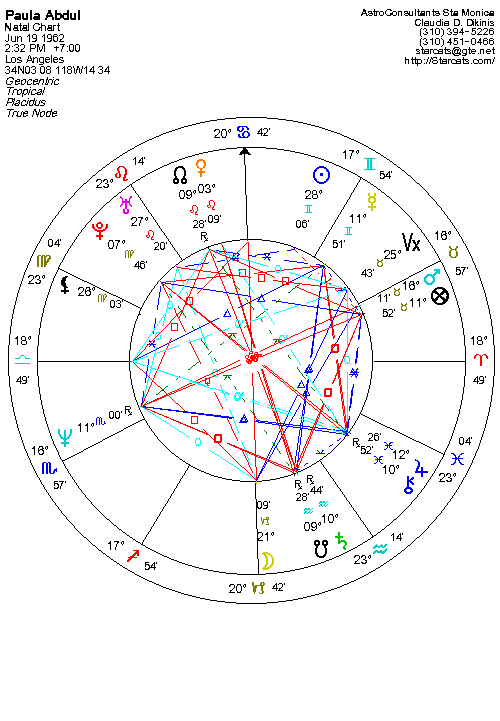| Delineation (chart analysis) is a matter of blending many pieces of a puzzle together to make a well-coordinated composite picture of an individual. A good astrologer judges a chart in its entirety, doesn't skip details, and uses a system.
Here is a suggested check list you can use to help you get started: - Hemispheric emphasis: how many planets are above and below the horizon (the ascendant/descendant, houses 1 and 7)?
- How many planets lie east or west of the meridian (the midheaven and nadir axis, houses 10 and 4)?
- Is there a chart signature? (count planets in elements -- fire, earth, air and water. Also in qualities -- cardinal, fixed and mutable).
- Is there a chart pattern? I.e., bucket, bowl, seesaw, locomotive, etc.?
- Are there any major configurations? I.e., Grand cross, grand trine, t-square, yod, kite, etc.?
- Which is the strongest planet? (The planet which is most heavily aspected, or one unaspected, or occupying the highest place in the chart [midheaven]).
- Stand outs: Do you find a lack of quality, an element or lack of aspects, such as no conjunctions, oppositions or squares?
- Locate the closest aspected planets in the chart. These are key to the native's chart.
- Does the chart have a final dispositor? Are there any mutual receptions?
- How many planets are dignified, exalted, in detriment or in fall?
- Check for critical degrees and fixed stars.
Once you have taken good notes using the suggestions above, you will have an overview or general feeling of the basic personality of the native. Now you are ready to take the chart apart and look for the native's potential and his/her character traits. Remember to keep the overall chart in mind. When analyzing any planet in a chart, keep the following in mind: - The basic nature of the planet (Moon = emotions; Mars = drive);
- The sign the planet occupies;
- The house the planet rules;
- The house the planetary ruler occupies. (A planet translates its energy from the house it rules to the house in which it resides);
ODDS & ENDS - If it's not in the chart twice, you're treading in thin ice.
- Personal planets across three adjoining signs usually indicate a developmental identity crisis which can be expressed many ways.
- People with no natal oppositions or an unaspected Mercury operate in a world of their own and often have trouble seeing other points of view.
- Watch out for conjunctions from your Neptune to others' personal planets or the ascendant. You may have a hard time staying focused and objective with these people.
- As above, so below -- astrology is a symbolic system of correlation and analogy. It is not causalilty system.
- What goes around comes around. It is wise to stay positive with your astrological interpretations.
- The ascendant is an interface; it reveals the face you present to the world and also mirrors back the face the world presents to you.
- A degree of longitude equals 50+ miles. The closer the aspect, the more intense it is likely to be.
- Planets with parallel latitudes have a relationship which operates like a conjunction. Those that are contraparallel relate to each other as through they were in opposition.
- Moon issues are primary and must be worked through before a person can function in a higher or more integrated/balanced way.
|




